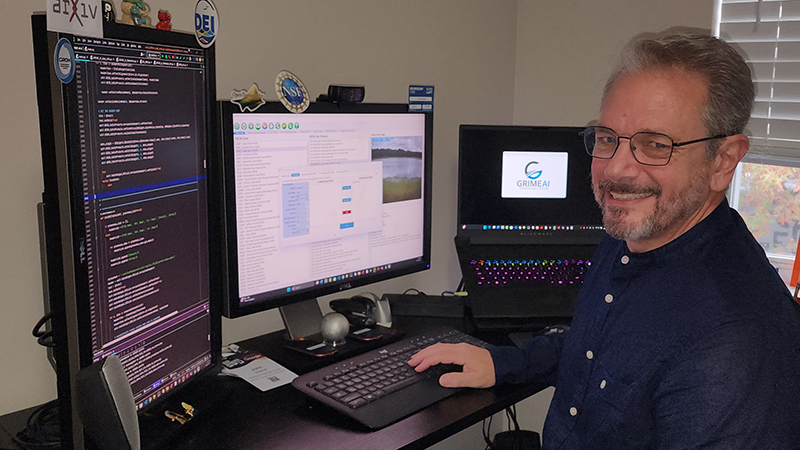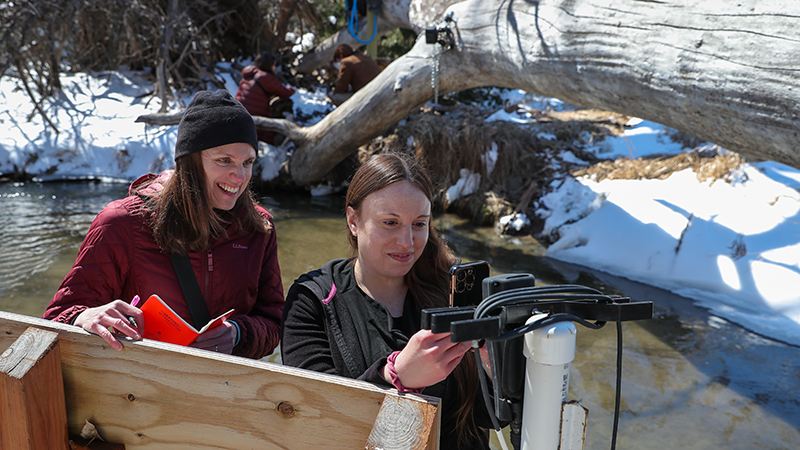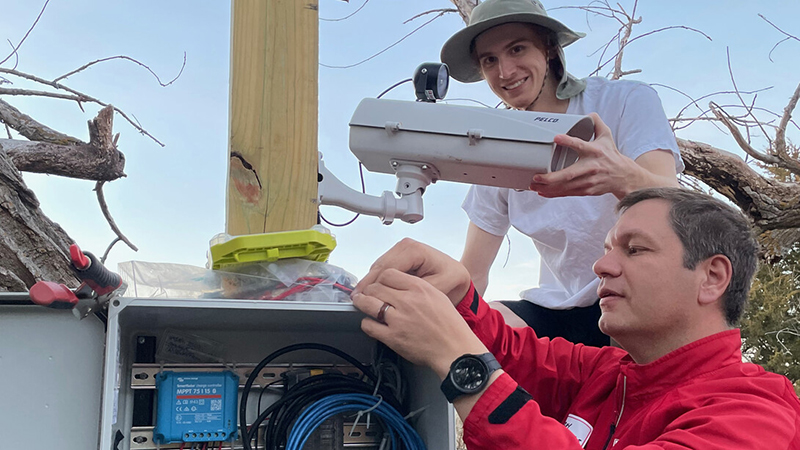Posted: 10/28/2025
Huskers launch GRIME AI, boosting research using camera networks

By Ronica Stromberg
University of Nebraska–Lincoln researchers have opened the gates on water research with the launch of GRIME AI September 16, 2025.
John Stranzl, a School of Natural Resources doctoral student advised by hydrology professor Troy Gilmore, developed the GaugeCam Remote Image Manager–Educational Artificial Intelligence software freely available on the GRIME Lab website. In just a few clicks, anyone can use the GRIME AI software to research water bodies that the National Ecological Observatory Network, PhenoCam and the U.S. Geological Survey monitor. The software streamlines access to about 1,000 cameras and their data drawn from recording water, plants and other parts of the environment.
Researchers can use images from their own camera networks to expand research opportunities even more. Those in the University of Nebraska system can combine the GRIME AI data with data drawn from the Platte Basin Timelapse photo network in the state. The Platte Basin Timelapse project has more than 70 cameras and has taken more than 5.5 million photographs of water and the surrounding landscape since 2011.
"When people see lots of time series of images, it raises questions, it opens up new ideas, and we're trying to give people the flexible tools to pursue research questions from across a variety of disciplines," Gilmore said.
He began work with Mary Harner, a communication and biology professor at University of Nebraska-Kearney, in 2020 to establish software that could use large photo networks for research. Ken Chapman, a former doctoral student, developed GRIME2 software on the GRIME Lab website to look at water levels. Stranzl, a nontraditional student with 35 years of experience in areas like software engineering, computer vision, robotics and machine learning, then developed the GRIME AI software launched this fall.
"Frankly, it's gone beyond what I originally envisioned because John Stranzl basically came in and just went with it," Gilmore said.
Stranzl said he created the software product to allow researchers to better spend their research dollars on carrying out the research itself rather than the "grunt work" of finding and cleaning data.

"The biggest issue I saw was researchers spend 80% of their time looking for the data, cleaning the data that they need, and so forth, and 20% of the time on the actual research," Stranzl said. "So, I proposed to Troy, I said, 'I want to flip that narrative.'"
Users can open the GRIME AI software, choose among the available locations to draw information from, pick from the list of data available for that site, give the time of day and date range desired, download the data to a folder and begin work on it.
"The idea is, rather than somebody going to a website and having to drill down and click through several pages or learn that very specific process for each individual website, instead, they can just open GRIME AI," Gilmore said.
Besides one-stop researching, the site offers tools to organize images and create figures from them with just a few clicks. With segmentation, the user can focus on the same part of multiple photographs taken at the same spot and angle over time. A slicer allows users to form a composite photograph with slices taken from multiple photographs. Users can show how a single photographic slice of the landscape changes over a time range they set. Or they can slice a photo multiple times and show the transition of time, like from season to season, through the slices.
Research possibilities become evident through the photographs and their manipulation. For example, a scientist might notice a change in water color at a spot over time and investigate the cause.
"You start to bring in other actual chemistry and isotopes and other methods alongside the imagery, and then you start to go after some new research questions about, for example, carbon transport in Sandhills streams," Gilmore said.

He has started his own list of possible research questions and come up with dozens. Added to that, people from different disciplines could look at the same images and come up with different questions, opening up interdisciplinary opportunities, he said.
"Once you start looking at the images and everything, it just starts generating ideas," Gilmore said. "Now, whether or not you can technically go and do that right now, and whether we need to build more tools, that's another question."
Within these first few weeks of launching GRIME AI, Gilmore's team has had three groups cold call them, asking about the software and ways to set up cameras and take part in the research. Three doctoral students from other universities are using the software in their dissertation research.
Stranzl said his experience at the University of Nebraska–Lincoln has been phenomenal, and he would like to continue working with the GRIME Lab and GRIME AI after graduating.
"I feel that with my experience in the commercial world and in the academic world, I could really make whatever career path I want going forward, but because there's been such an incredible synergy between Troy and Mary and myself, I really think that GRIME Lab is it," he said. "I think we can make this bigger and even better than we have already envisioned."
Gilmore said one of the next big steps he anticipates is writing a proposal with Platte Basin Timelapse for a joint project.
"That really kind of lifts both boats," he said. "I think we can really chase that now that we have this tool in place."
The National Science Foundation, U.S. Geological Survey, Daugherty Water for Food Global Institute and the University of Nebraska Collaboration Initiative helped fund GRIME AI.
See Troy Gilmore's talk on October 29, 2025 as part of the SNR Seminar Series at https://www.youtube.com/watch?v=nomVd2kvQeU
